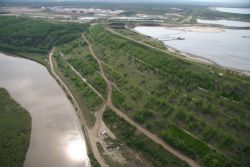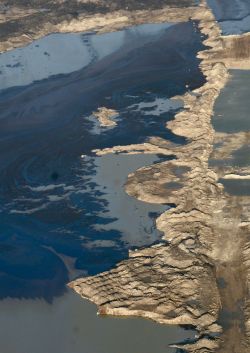When the Energy Resources Conservation Board (ERCB) rolled out new regulations to manage oilsands tailings production (Directive 074) in February 2009, my colleagues and I were hopeful that a new, tougher approach to regulating oilsands development had begun. But based on past experience, we were cautiously optimistic at best.
At the time, my colleague Jennifer Grant responded: "Given the very weak track record of the ERCB and the Government of Alberta in implementing and enforcing oilsands environmental regulations, it may take two to five years to determine if this directive has teeth."
 But to our pleasant surprise, as deficient tailings (a toxic liquid byproduct of oilsands production) management plans started piling up (our review with Water Matters found seven of nine plans failed to meet the regulations), the ERCB continued to talk tough.
But to our pleasant surprise, as deficient tailings (a toxic liquid byproduct of oilsands production) management plans started piling up (our review with Water Matters found seven of nine plans failed to meet the regulations), the ERCB continued to talk tough.
An ERCB spokesperson, told the Fort McMurray Today the new rules would have more "teeth" and specifics than past rules, and went on to predict that within the next two years, the board would be able to look at targets outlined by companies. If anyone falls short, the regulator would step in and take enforcement action, ranging from increased audits and inspections to shutting an operation down. The spokesperson said, "That gives you a lot of power to get things done."
In another interview with Dan Healing, a reporter with the Calgary Herald (for a story later picked up by other PostMedia Network newspapers), an ERCB representative asserted: "The directive was passed last February after pretty extensive consultation. ... We went over it to see if there were any deal-breakers, anything that the companies would be unable to comply with, so the final directive was something the companies would be able to comply with."
An ERCB spokesperson also told Global News, "... all projects will meet the ERCB tailings standards if they want to operate in Alberta."
To the Edmonton Journal, an ERCB representative said the regulator prides itself on rules that are fair, achievable and enforceable, and went on to say, "This is the first time in the history of the oilsands that companies have had to meet this kind of a requirement. We are trying to work with them, but at the end of the day those standards will have to be met."
In another story, the ERCB continued singing the same tune stating, "Companies are expected to be compliant with the regulations as they stand now. And if they are not compliant they won't be approved."
With all the tough talk, we remained hopeful. And Suncor's October 2009 commitment helped us stay that way for a while. The oilsands operator committed to a n ew approach to tailings management that would comply with the new regulations — a clear signal that the industry had the technological and financial capacity to step up and begin addressing their toxic tailings.
ew approach to tailings management that would comply with the new regulations — a clear signal that the industry had the technological and financial capacity to step up and begin addressing their toxic tailings.
My colleague Simon Dyer stated at the time, "Suncor's proposal raises the bar for all companies operating in the oil sands, and it is essential that other oilsands companies are required to meet the new rules to deal with toxic tailings waste."
But by April of this year, after months of behind-closed-doors negotiations with oilsands companies, the ERCB did a 180 degree spin from its tough talk of 2009 by approving Syncrude's non-compliant tailings management plans.
That's right, the regulator approved a plan by a company that clearly stated it would not meet the regulations. Even more ironic was the fact that this about face came the day after Alberta Premier Ed Stelmach used Earth Day to declare that his government would force an end to oilsands tailings ponds.
ERCB spokespeople have now started talking about taking a "collaborative" approach with industry, suggesting that it's "reasonable" to give companies who aren't meeting the regulations some flexibility. Indeed, on the ERCB's approval of Syncrude's plans, one spokesperson told CTV that Syncrude "might not have been satisfying the letter of the Directive until 2014 but they were certainly obeying the spirit of it."
In August, the ERCB approved Imperial Oil's tailings management plan, which also fails to meet the regulations. Astonishingly, a supposed state-of-the-art oilsands mine, just approved in 2007, is unable to meet basic clean up rules for another eight years — something doesn't add up.
Once again, we find ourselves commenting about weak implementation and government regulators who seem to lack the willpower to enforce their own regulations.
So this week on behalf of the Pembina Institute and Water Matters, Ecojustice filed an application with the ERCB requesting approval of Syncrude's non-compliant tailings management plans be withdrawn until they are brought in line with the ERCB's tailings management directive. By our estimation, the ERCB doesn't have the legal authority to approve plans that are not in compliance with the directive.
Stay tuned for the outcome.









